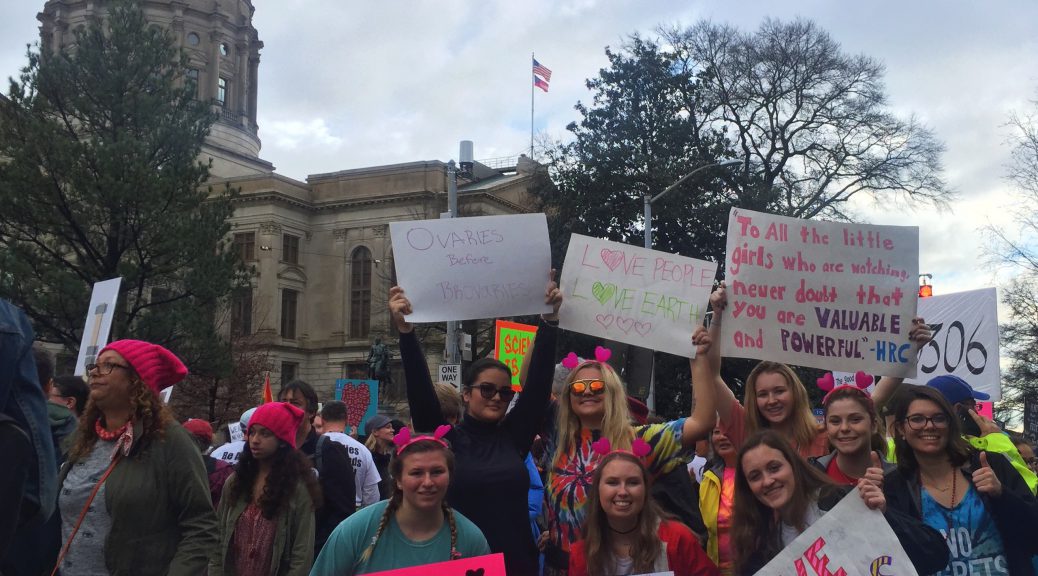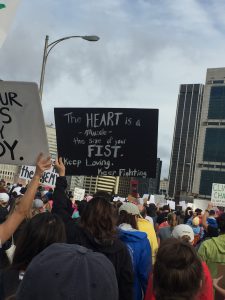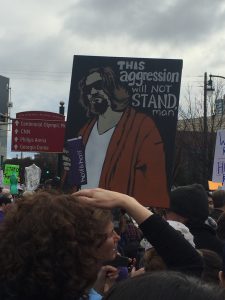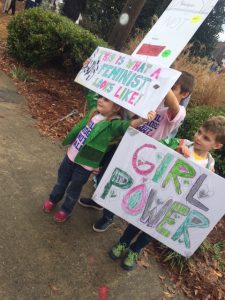The sky was filled with clouds and rain dripped on many as they marched through downtown Atlanta. Crowds gathered with diverse faces including men, children and elders. Streets were filled with bodies from the Georgia Aquarium to Underground Atlanta to the Georgia State University campus.
Around 11 a.m. on this wet and rainy day, Allie Schank, Ana Duron and Kristen Nicolosi drove to Buckhead, Georgia. They hooped on a Marta train towards the Civic Center stop in downtown Atlanta. The train was filled with people with the same intent of heading into the big city.
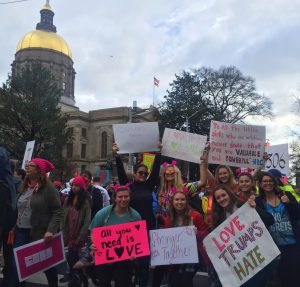
Stepping off the train, the four girls joined a full crowd of participants holding up signs, holding hands and chanting. The streets were covered with puddles, but at least the rain had stopped. The sun started to peak through the dark, grey clouds.
“Our very politically active friends, Ana and Emily invited a bunch of us to go. It was raining so a lot of our friends backed out, but I still went,” said University of Georgia freshman Kristen Nicolosi who is a double major in exercise and sport science and athletic training from Westchester, Pennsylvania.
“We missed Congressman John Lewis speak, but we were there for most of the day. The environment was very inspiring,” said sophomore Allie Schank who is a marketing major from Atlanta, Georgia.
“We are not super political, but we knew we were in an important moment,” Nicolosi said.
Atlanta was just one of the cities who participated in the Women’s March. According to the New York Times, Atlanta had a reported 60,000 people in attendance. Speakers such as the Georgia House Minority Leader, Stacey Abrams, Staci Fox, the President and CEO of Planned Parenthood Southeast and Francys Johnson, President of the Georgia NAACP chapter were all in attendance to speak at the march.
Pink hats, gloves and scarves covered many bodies on the day of Jan. 21, 2017. A sea of pink was everywhere from the coasts of California to the icy streets in Washington, D.C. to places such as Europe and Australia. Chants and phrases like “hey, hey, ho, ho, Donald Trump has got to go,” “Nasty Women” and “Who are you to tell me my rights,” were shouted by many.
Speakers such as America Ferrera, Scarlett Johnasson, Madonna, Gloria Steinem and Sen. Elizabeth Warren spoke in Washington on women’s rights.
Little girls walked hand in hand with their mothers. Those mothers walked hand in hand with their mothers. Husbands and brothers held hands and signs in solidarity.
On Jan. 21, the Women’s March organization coordinated an international march. According to their website, the march was a symbolization of unity on the behalf of standing issues such equal pay, marginalized groups, survivors of sexual assault, disabled groups, immigrants. They believe women’s issues are human issues.
The national team from the women’s march is a combination of former staff from the Obama administration, social issue activists, CEO’s of fashion companies, community organizers and lawyers. This solid group of female bosses united people all over the world to come together and protest.
According to the New York Times, Washington D.C., Chicago and New York City were the most heavily populated in participation.
According to the New York Times, attendance in New York City was more than 400,000, Washington D.C. was an expected 500,000, Chicago had an estimate of 250,000, Boston was an estimate 175,000 and in Phoenix there were 20,000 people.
http://https://storify.com/kds67272/women-s-march
The marches in January represent the continuous effort by women to achieve equality in the United States and the world.
Susan Haire, a professor at the University of Georgia, decided to go to Washington D.C. for the Women’s March because of prior living in D.C. Her granddaughters are also living there currently. Haire is a faculty member of the political science department, an alumna of the university and currently teaches gender, law and policy.
“My mother, who is 80 years old, was the one who really wanted to go to the march and you never want to regret not going to something like that,” Haire said.
“It did not take us long to get there. Once I got to the march, I noticed it was very clever. I was expecting something different and was happy to find out people like me were attending,” said Haire.
“The crowd was a good nature. There were young families and lots of men. People were very kind. There was a slightly tall step we had to get over to leave and the people actually helped my mother over by gracefully lifting her,” Haire said.
“The signs were hilarious. I would have never thought to come up with anything like the ones I saw. Even dogs were wearing signs,” said Haire.
The march was scheduled the day after President Trump’s inauguration. The movement had some criticism because it was looked at as an “anti Trump” protest.
“Oh no. I don’t think his name was even associated with the march,” said Duron. “It wasn’t a ‘tear him down or build him up’ type of situation. He was more non involved with it. It was more about the repetitive rhetoric that his administration was pushing that I think people had a problem with. It was the straw that broke the camel’s back. Or maybe even a brick. All I know is that it was a very heavy straw.”
“The rhetoric of the administration was just not appealing,” said Haire. We were starting to see people in the political realm acting out of character and supporting legislation that we had not seen before. It was also that the voice of women had begun to become lost or was not important and I think that had a lot to do with the reasoning behind the march. Also I was not a fan of the leaked Access Hollywood video. Personally that rubbed me the wrong way.”
Back at the university, students such as Duron and professor Haire still believe there is work to be done on our own campus revolving the issues brought up in the march.
According to the University of Georgia 2007 fact book. There were a total of 25,335 undergraduates and 14,348 were female undergraduate students.
Of the 25,335 undergraduates, 4,470 students were minorities.
Today, there is still more women attending than men. Also there is an increase in the number of minorities. The percentage of minorities attending has increased by roughly 11 percent.
According to the University of Georgia fact book in 2016, there are 27,951 undergraduate students and 15,742 of them are female, which is a little over half.
Of the 27,951 undergraduate students, 8,061 of them are minorities, which is a little over a third of the University of Georgia’s undergraduate population.
The four attendees of the women’s march sit around a large wooden table in the Miller Learning Center, arms spread out into fists as they express their points. Eyes wonder, roll and then focus in. Heavy breathing occurs as they recollect their thoughts about the culture of the campus and if it aligns with the values shown in the women’s march.
“I think our campus culture is getting better. I think it has to do with having more women attending, but there is a large southern culture displayed here, so it is still hard to gain respect as a woman,” Schank stated.
“The opportunity is there though. We have so many events to discuss these issues,” Nicolosi looking at Schank argued back.
Professor Haire, being alumni of the university, has seen different eras of equality efforts on campus and in Athens. She discusses the dynamic of the campus with women’s issues.
Haire believes that our university, given that it is located in the South does make an effort to be aware of the issues women and minorities face. Haire also notes that we do not compare to the many northern cities and universities who had larger amounts of participation in the marches like Washington D.C., New York and Chicago.
“… Compared to when I was an undergraduate here, it is a lot better,” Haire explains.
Professor Haire also believes the “culture of empowerment especially with the issue of sexual harassment is important and enforcing the ‘no means no.’ is an area we can improve on.”
Looking at the efforts given by women this year, conversations are being brought to the table about issues women face all over the country and even in Athens.
“The university is all about moving forwards and engaging in those conversations and I think President Morehead has been very adamant in moving us in that direction,” Duron said.

